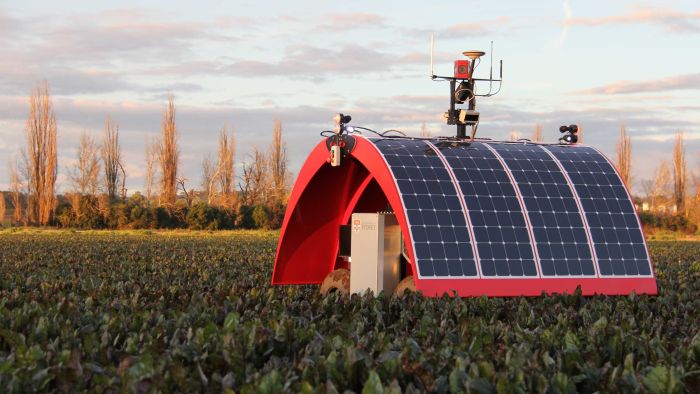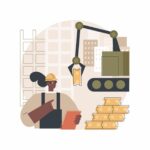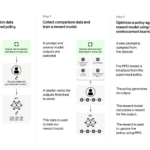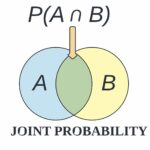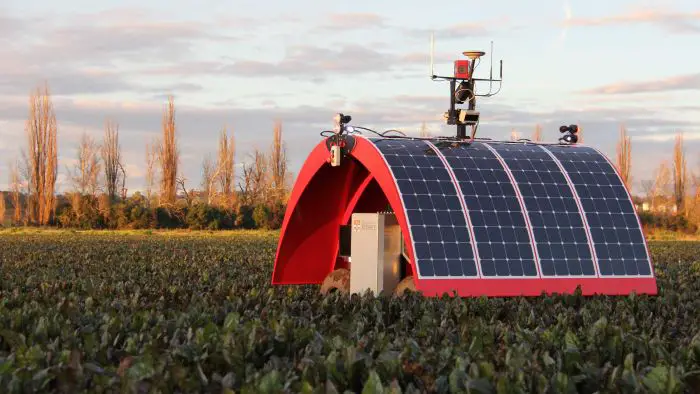
Introduction
The world of tech is booming, and with it, the agricultural industry is changing too. With new technology comes new ways to increase production, decrease costs and save time. One of such innovations is the use of robotics in agriculture.
Robotics in agriculture is not a new concept. In the past, robots have been used for tasks such as crop picking and milking cows. However, these were all large, cumbersome machines that required a lot of infrastructure and manpower to operate. With the advances in technology, agricultural robots are becoming smaller, more agile, and more autonomous.
Table of contents
What is Ladybird Farming Robot
There has been a lot of talk about agricultural robots in recent years. There are many different types of these robots, but one that has particularly caught the attention of the public is the Ladybird Farming Robot. Developed by Dr. Salah Sukkarieh of the University of Sydney, the Ladybird is a small autonomous robot that can be used for a variety of tasks on the farm.
Here we will give an overview of the Ladybird Farming Robot, its features, and some major benefits that it can bring to the agricultural industry.
The Ladybird farming robot is an autonomous agricultural robot developed by Salah Sukkarieh and his team in Australia. The robot is designed to perform a range of tasks on farms, including pest detection and control, crop monitoring, and nutrient deficiency detection. This robot is unique as it is designed to operate at night, when most other agricultural robots are not in use. This allows the Ladybird to perform tasks that are otherwise not possible with other agricultural robots. It also helps cover large hectares at night in a short period of time.
Ladybird farming robot is solar powered with the ability to store excess power in a battery which allows it to harness the power of solar energy at night. This strategy will slowly but surely become common as solar panels improve in the future. This technology allows ladybird robot to work at night, which in traditional farming is not possible.
The Ladybird robot is also equipped with an array of sensors, including spectral cameras, that allow it to detect crop health in real-time. The robot also has a manipulator arm that can be used to remove pests from plants and perform tasks such as picking fruit or vegetables.
The robot also has specialized equipment for performing tasks such as picking and pruning. It also has the potential to be used for other tasks such as soil sampling and mapping. Moreover, it is powered by solar panels, which makes it environmentally friendly.
The Ladybird farming robot is a prototype that is currently being tested on farms in Australia. The aim of the project is to develop a working model of the robot that can be used by farmers to increase efficiency and revolutionize the future of agriculture.
Also Read: Smart Farming using AI and IoT.
The Ladybird: World’s First Intelligent Farm Robot Advances Agricultural Technology
The Ladybird farming robot has the potential to revolutionize the agricultural industry, as it can perform many tasks that are currently performed manually. This would free up farmers’ time, allowing them to focus on other tasks, and would also reduce the production cost of crops.
Farming costs are currently high due to the need for manual labor. The vegetable industry is particularly labor intensive, as farmers need to manually remove pests from crops. The Ladybird farming robot can automate this process.
The use of robots on farms would reduce multiple costs, as robots can work for longer hours and do not require breaks. In addition, robots can be used in all weather conditions, which would further reduce costs.
One of the key benefits of the Ladybird farming robot is that it can assist farmers in detecting and removing pests, which is a significant challenge in horticulture. The digital farmhand could also help farmers with tasks such as picking and pruning. Additionally, nutrient deficiency detection is another area where the robot could be used.
The robot is still in development, but it is hoped that it will soon be able to perform all of the tasks of farming, autonomously. It is the world’s first intelligent farm robot, and it will play a pivotal role in the future of agriculture. The Ladybird is currently being tested and it is hoped that it will soon be available to farmers all over the world.
Also Read: Automated Farming.
How does the Ladybird robot work?
The Ladybird robot operates using artificial intelligence algorithms. These algorithms allow the robot to learn and adapt to its surroundings. One of the key features of the Ladybird farming robot is its classification algorithms. These algorithms enable the robot to identify and classify different types of plants. This is a crucial function, as it allows the robot to distinguish between crops and weeds.
The classification algorithms are constantly being improved, as the team behind the project aims to make the robot as intelligent as possible. The aim is for the robot to be able to identify and classify all types of plants and be as intelligent as possible.
Technical Features of the Ladybird Farming Robot
The Ladybird Farming Robot is equipped with an array of state-of-the-art technical features that revolutionize agricultural operations. One of its primary features is its solar-powered system, a reliable and eco-friendly energy source that facilitates extended operations. The robot’s sleek design includes multiple articulated arms, which are utilized to perform a variety of complex tasks including planting, weeding, and data collection. Each of these arms is embedded with a range of sensors for detecting and distinguishing between different types of crops and weeds.
The robot’s navigation and movement system is another crucial technical feature that sets the Ladybird apart. Employing advanced computer vision and GPS technologies, it enables the robot to move around autonomously in the field with pinpoint precision. This autonomy is particularly beneficial when undertaking tasks like crop monitoring and precise application of fertilizers or pesticides. Furthermore, the robot’s differential drive system allows it to maneuver around obstacles, making it adaptable to different field conditions and terrains.
On the data management front, Ladybird’s embedded system handles a large volume of data collected from the field. This system comprises advanced machine learning algorithms and data processing modules, which aid in analyzing the collected data to make informed decisions about crop health and growth patterns. The robot is also capable of real-time communication, transmitting critical data to farmers or other agricultural professionals for immediate decision making. This data-driven approach empowers farmers to optimize their resources, make timely interventions, and ultimately, improve crop yields.
Artificial Intelligence in Ladybird: The Role of Computer Vision and Machine Learning
Artificial intelligence (AI) forms the backbone of the Ladybird Farming Robot, with computer vision and machine learning being two of its most crucial components. Computer vision is integral to the robot’s operational capacity. Using advanced sensors and cameras, Ladybird’s computer vision system captures images and videos of the agricultural field, enabling the robot to detect, identify, and classify different types of crops and weeds. This capability is particularly useful in executing tasks like precision weeding, where the robot must distinguish between crops and weeds accurately to prevent crop damage.
Machine learning plays a pivotal role in enhancing the accuracy of Ladybird’s decisions over time. Leveraging machine learning algorithms, the robot can learn from past experiences and continually improve its actions. For instance, the more data it gathers about different types of crops and weeds, the better it gets at distinguishing between them. Machine learning also plays a crucial role in predictive analytics. The data collected from the fields is analyzed to forecast crop growth patterns, predict possible pest attacks, and assess the health of the crops. These insights enable farmers to make proactive decisions and improve crop yield significantly.
The combination of computer vision and machine learning fosters a powerful feedback loop in Ladybird. As the robot collects more visual data from the fields, this data is fed into its machine learning models, enhancing their predictive capabilities. In return, these refined models provide more accurate data interpretation to the computer vision system, enabling it to perform its tasks with increased efficiency and precision. In this way, the synergy between these two AI components significantly amplifies Ladybird’s overall effectiveness in agricultural operations.
Navigational Capabilities of the Ladybird Farming Robot
The Ladybird Farming Robot exhibits impressive navigational capabilities that are essential for its effective operation in diverse agricultural environments. The robot uses a combination of GPS and onboard sensors to navigate autonomously around the farm. This system allows Ladybird to traverse the agricultural fields accurately, avoid obstacles, and efficiently execute tasks such as monitoring crop health, precision spraying, and mechanical weeding. The GPS enables the robot to locate its exact position within the farm, thus ensuring precise coverage of areas that need attention. Meanwhile, the onboard sensors like LIDAR and cameras help detect potential obstructions, changes in terrain, and other environmental variables.
One of the advanced features of Ladybird is its ability to perform in row-following tasks. This means it can autonomously navigate through the crop rows, recognizing each plant as an individual object. The use of machine learning techniques further enhances this capability. For instance, machine learning algorithms are used to analyze sensor data, enabling the robot to learn and adapt to different farm conditions over time. This adaptability ensures that Ladybird can operate effectively across a wide range of crop types and growth stages, making it a versatile solution for diverse farming needs. These navigational capabilities are critical in ensuring that Ladybird can function independently and reliably, thereby reducing the manual labor requirement and increasing overall farm productivity.
Crop Monitoring and Weed Control with Ladybird
Crop monitoring and weed control are two of the key functions of the Ladybird farming robot. With its high-resolution cameras and advanced sensor technology, Ladybird can systematically capture images and data as it navigates through the fields. These images and data provide invaluable information about the health and growth status of the crops. The robot uses machine learning algorithms to analyze the collected data, detecting any signs of disease, pests, or nutritional deficiencies. This ability allows for early intervention, ensuring that potential problems are addressed promptly to minimize yield loss.
In terms of weed control, the Ladybird farming robot offers an effective and eco-friendly solution. Equipped with a precision spraying system, Ladybird can accurately apply herbicides to specific areas infested with weeds. The robot uses computer vision to differentiate between crops and weeds, ensuring that the herbicides are applied only to the unwanted plants. This targeted approach reduces the amount of herbicide needed, lowering both costs and environmental impact. In addition, Ladybird also has the capacity for mechanical weeding. Using its robotic arm, the robot can physically remove weeds from the ground, providing an alternative, chemical-free method for weed control. These functionalities contribute to sustainable farming practices, highlighting the transformative potential of robotic technology in agriculture.
The Use of Hyperspectral Imaging in Ladybird
The Ladybird farming robot utilizes hyperspectral imaging, a powerful tool that enables comprehensive crop analysis and monitoring. Hyperspectral imaging sensors capture and process information from across the electromagnetic spectrum, including the visible and non-visible wavelengths. This technology provides detailed information on the health and condition of the crops, as it can identify materials and substances based on their spectral signatures. For instance, it can detect the presence of certain diseases or nutrient deficiencies that would not be visible to the naked eye.
In the context of Ladybird, the data collected through hyperspectral imaging is analyzed using machine learning algorithms. The robot can then identify any areas of the field where the plants are stressed or unhealthy, allowing for targeted interventions. This leads to improved crop management and increased yield, as issues can be detected and addressed before they cause significant damage. As the hyperspectral data is captured in real-time, farmers are provided with a dynamic and accurate overview of their fields, facilitating informed decision-making regarding irrigation, fertilization, and pest control. Therefore, the integration of hyperspectral imaging in the Ladybird farming robot presents a significant advancement in precision agriculture, demonstrating the potential of AI and robotic technology in enhancing farming efficiency and sustainability.
What are the benefits of Ladybird robotic farming?
The Center for Field Robotics often talks about the potential for agricultural robotics, and they’ve outlined some of the benefits that these systems can have. Here are some of the potential benefits of Ladybird robotic farming:
- Increased efficiency – Automation can help to increase efficiency in agriculture by reducing the need for manual labor. This would free up farmers’ time, allowing them to focus on other tasks, and would also reduce the production cost of crops.
- Improved crop yields – The use of robots on farms would reduce multiple costs, as robots can work for longer hours and do not require breaks. In addition, robots can be used in all weather conditions, which would further reduce costs.
- Micro dosing – The robot will be an expert in measuring the dose of chemicals that should be used on plants. This will help to reduce the number of chemicals that are used in agriculture, which is better for the environment.
- Soil sampling and mapping – The robot is still in development, but it is hoped that it will soon be able to perform all of the tasks of farming, autonomously. It is the world’s first intelligent farm robot, and it will play a pivotal role in the future of agriculture.
- Precise application of water, fertilizers, and pesticides – The digital farmhand could also help farmers with tasks such as picking and pruning. Additionally, nutrient deficiency detection is another area where the robot could be used.
- Detection of diseases – The robot with some further enhancements will also be able to detect diseases in plants and send alerts to the farmers.
- Alerts about the crop yield, nutrition, and properties – The sensors on the ladybird can also be used to monitor the yield, nutrition, and properties of crops. This information can be used by farmers to make decisions about how to care for their crops.
- Autonomous surveillance – The Ladybird can also be used for autonomous surveillance of crops. This would allow farmers to know if there are pests or diseases present in their crops without having to manually check them.
These are only some of the potential benefits that agricultural robotics can have. As the technology develops, there are sure to be even more benefits that are discovered. Several robotics experts agree that agricultural robotics has the potential to make it more efficient and sustainable through intelligent systems.
Also Read: Role of artificial intelligence in agriculture.
What challenges can Ladybird face?
The development of agricultural robotics is still in its early stages, and there are sure to be challenges that need to be overcome. These include:
- Infrastructure – One of the challenges that will need to be addressed is the infrastructure of farms. In order to implement robotics on a farm, there will need to be changes made to the way that crops are grown. This includes changes to the layout of fields, as well as the introduction of new technologies.
- Cost – Another challenge that needs to be addressed is the cost of these systems. Agricultural robotics is a new technology, and the systems are sure to be expensive. However, as the technology develops, the cost is likely to decrease.
- Training – Farmers will also need to be trained on how to use these new technologies. This includes training on how to operate the robots, as well as how to troubleshoot them.
- Public perception – There is also a challenge in terms of public perception. There is a general mistrust of new technologies, and this may be amplified in the case of agricultural robotics. Farmers will need to be convinced of the benefits of these systems before they are willing to adopt them.
Also Read: Role of artificial intelligence in agriculture.
Final Thoughts
Robotics and autonomous systems are playing an increasingly decisive role in the future of agriculture. The development of agricultural robots has the potential to revolutionize farm processes and the vegetable industry by automating tasks that are currently performed manually.
Autonomous mechanisms are being developed to satisfy the need for a more efficient and environment-friendly agricultural production. The Ladybird robot is one of these autonomous agents that has been designed specifically for agricultural purposes. It is not only an autonomous robot farmer but also the first of its kind. With time, the Ladybird robot is expected to carry out all the tasks involved in farming, making it a game-changer for the agricultural industry.
Conclusion
The Ladybird farming robot signifies a significant leap in the domain of agricultural robotics, utilizing advanced technologies to revolutionize farming practices. This autonomous robot employs a diverse range of sensors and algorithms to efficiently navigate the fields, identify and monitor crops, and carry out farming tasks such as weed control and yield estimation. The innovative design of Ladybird allows it to perform operations around the clock, regardless of weather conditions, leading to higher efficiency and productivity.
The influence of AI in the operation of Ladybird is quite notable. The robot leverages computer vision and machine learning techniques to identify and classify different plant species and distinguish between crops and weeds. It can accurately pinpoint the location of each plant and evaluate its health using hyperspectral imaging. The collected data is then processed on-board, allowing the robot to make real-time decisions. This application of AI brings a significant level of precision to farming, helping to optimize resource use and improve yield quality and quantity.
Despite its significant advancements, the future of Ladybird and similar technologies still faces challenges, primarily centered around its broader adoption. Technological barriers, high initial costs, and farmer’s skepticism towards new technologies may slow the widespread implementation of such systems. However, as these robots prove their potential and provide a return on investment, their use is expected to increase. The evolution of the Ladybird farming robot represents a fascinating case of how AI and robotics can contribute to sustainable and efficient farming, potentially shaping the future of agriculture.
References
Kose, Utku, et al. Artificial Intelligence and Smart Agriculture Technology. CRC Press, 2022.
Zhang, Dan, and Bin Wei. Robotics and Mechatronics for Agriculture. CRC Press, 2017.



